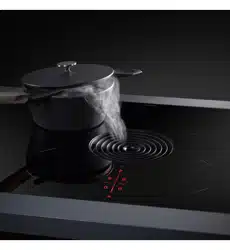Loading ...
Loading ...
Loading ...

EN
50
Cleaning and Maintenance
www.bora.com
8 Cleaning and
Maintenance
Observe all safety and warning information
(see the Safety chapter).
Follow the enclosed manufacturer’s information.
When conducting scheduled cleaning and
maintenance, ensure that the cooktop and cooktop
extractor are fully switched off and cooled so as to
prevent injury (see the Operation chapter).
Regular cleaning and maintenance ensures long
service life of the product and optimal function.
Adhere to the following cleaning and maintenance
cycles:
Component Cleaning cycle
Operating panel Immediately after every soiling
Cooktop Clean with conventional glass ceramic
detergents immediately after soiling and
on a weekly basis
Cooktop extractor Weekly
Air inlet nozzle and
stainless steel filter
After cooking very greasy dishes; at
least once a week, when the fan level
indicator shows
F
clean by hand or in
the dishwasher (at 65 °C max.); clean the
stainless steel surfaces in the polishing
direction only!
Air guiding housing Every 6 months or when replacing the
activated charcoal filter
Activated charcoal filter
(with recirculation only)
Replace if odours have built up,
extraction power is dwindling or the fan
power level indicator shows
F
Tab. 8.1 Cleaning cycles
8.1 Cleaning agents
INFO Due to the use of aggressive cleaning agents and
abrasion caused by the pot bases the surface will
become damaged and dark stains will occur.
To clean the cooktop, you need a special glass ceramic
scraper and suitable cleaning agents.
Never use steam cleaners, abrasive sponges, scouring
pads or chemically aggressive cleaning agents (e.g.
oven cleaner spray).
Make sure that the cleaning agent does not contain
any sand, soda, acids, lyes or chloride.
For air inlet nozzle and grease filter
Do not use any aggressive cleaning agents or agents
containing acid or lye.
8.2 Cooktop and extractor care
Never use the cooktop as a work or storage surface.
Do not push or pull cookware over the cooktop.
Always lift pots and pans.
Keep the cooktop and extractor clean.
Remove any dirt immediately.
Only use cookware suitable for glass ceramic cooktops
(see Appliance description chapter).
8.3 Cleaning the cooktop
INFO When the cooktop extractor is in use the air inlet
nozzle must be fitted so that no small or light
objects such as fabric or paper cleaning cloths
can be sucked in.
Make sure that the cooktop is switched off (see the
Operation chapter).
Wait until all cooking zones are cold.
Remove all coarse dirt and food residues from the
cooktop using a glass ceramic scraper.
Apply the cleaning agent to the cold cooktop.
Spread the cleaning agent using kitchen roll or a clean
cloth.
Wipe the cooktop clean with a damp cloth.
Dry the cooktop with a clean cloth.
If the cooktop is hot:
Remove stubborn residues of plastic, aluminium foil,
sugar or sweet dishes from the hot cooking zone
immediately using a glass ceramic scraper to prevent
burning.
Heavy soiling
Remove heavy soiling and marks (limescale marks,
mother-of-pearl-like shiny marks) using cleaning
products while the cooktop is still warm.
Wipe off food that boils over with a damp cloth.
Remove any remaining dirt with the glass ceramic
scraper.
Always remove any seeds, crumbs or similar that
fall onto the cooktop during cooking immediately to
prevent the surface getting scratched.
Any changes in colour or glossy spots are not damage to
the cooktops. They do not affect the functionality of the
cooktop or the stability of the glass ceramic panel.
Changes in the colour of the cooktop are the result of
residues which have not been removed and have burnt
on.
Glossy spots are the result of wear by the pan base,
especially if aluminium-based cookware or unsuitable
cleaning agents are used. These are difficult to remove.
Loading ...
Loading ...
Loading ...
